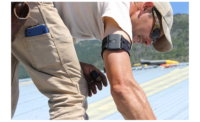Lack of blood to the brain causes fainting. To avoid fainting, move around and shift body weight from one leg to the other.
Employees who have heart problems or are on a low sodium diet under the recommendation of a physician should consult their physician on how to handle working in hot, humid environments.
Prevention of Heat Stress
If your company has hot and/or humid work environments, take steps to protect employees from heat stress hazards. Establish a program for gradually acclimating employees to the hot environment.
Consider the following elements in a program:
• Train employees to recognize heat-related illnesses. Train them in preventative measures and in proper first aid techniques to treat these illnesses.
• Encourage employees to drink five to seven ounces of water every 15 to 20 minutes throughout the day. In the course of a day’s work, the body may produce as much as two to three gallons of sweat. These fluids should be replaced at nearly the same rate as they are lost. Cool, clean, palatable drinking water should be readily available. Employees should not depend on thirst to signal when or how much water to drink since thirst is a poor indicator of the actual need for fluids.
• Where possible, use engineering controls such as mechanization of a process, installation of heat shields, or installation of ventilation, to remove the heat and/or humidity from the work environment.
• Allow new employees and those returning from an illness or vacation to gradually become accustomed to the heat. Require them to work for short periods in the heat and then work in other cooler jobs. The human body becomes acclimatized to the heat in about five to seven days. During this time, the body will undergo changes that will enable it to better withstand heat and humidity. The body will sweat more and will not lose electrolytes as quickly.
• Implement a program of work-rest cycles. Shorter work-rest cycles are required for more strenuous physical work and hotter environments. Work periods should be followed by periods of rest in a cooler environment (about 76 degrees).
• Encourage employees to add extra salt to food if salt replacement is needed. Salt tablets should not be used.
• Use protective equipment such as reflective clothing, reflective face shields or insulated or ventilated suits when necessary. There are vests and clothing available from safety equipment suppliers that utilize air streams or water inside tubes to cool the employee. There are also items of clothing that contain pockets in which ice can be placed.
Greg Summerhays is director of public relations and community outreach at Workers Compensation Fund, which offers ongoing safety training. Visit www.wcfgroup.com for more information.




Post a comment to this article
Report Abusive Comment